Bastogne M4A3(75)W Sherman
This Surviving M4A3(75)W Sherman Tank in Bastogne took part in the 1944 WW2 Battle of the Bulge in the Belgium Ardennes. It has been restored and can be seen in the main town square in Bastogne at the junction of the Rue de Neufchateau with the Rue Joseph-Renquin.
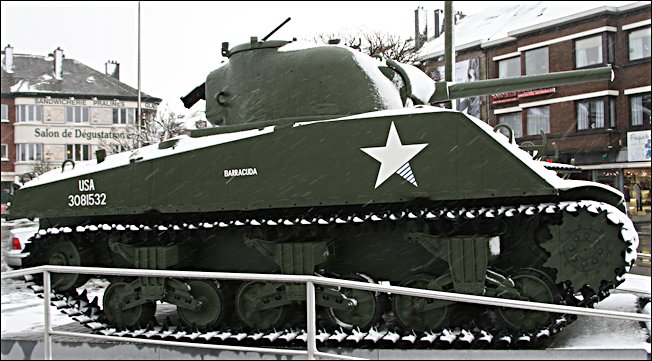
Snow covered M4A3 Sherman Tank armed with a short barralled 75mm gun in Bastogne Belgium
The Sherman tank named Barracuda
The tank was named Barracuda by its crew. It has the serial number S48935 USA 3081532 and was built at Fisher. It served with B Company 41st Tank Battalion, 11th Armored Division. On 30th December 1944 the tank crew were ordered to attack the south flank of the 'Bulge' from a northerly position. What they did not realise was that they were attacking into a simultaneous German counter attack that was intended to. close the narrow corridor that had been opened into the Bastogne perimeter from the south.
The nearby villages of Lavasalle and Houmont were successfully liberated by Combat Command B of the 11th Armoured Division but they suffered significant casualties. Early in the action the Sherman tank 'Barracuda', commanded by Staff Sergeant Wallace Alexander, and another Sherman commanded by Captain Robert L.Ameno, had become separated from the rest of their unit. They decided to move north to try and find them and headed towards the village of Renuamont, not realising that this was German held territory.
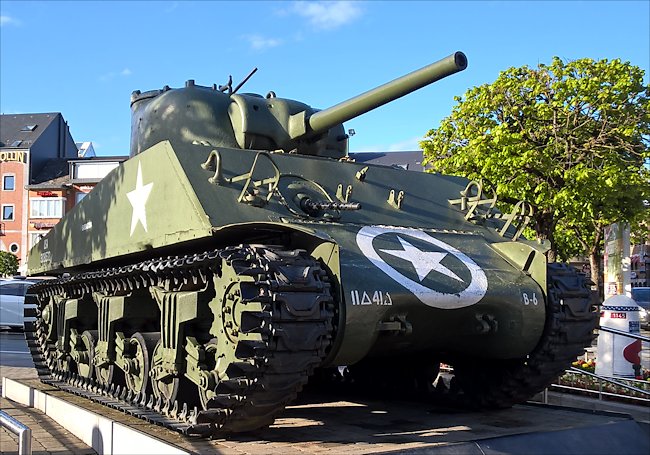
M4A3(75)W Sherman Tank in Bastogne, Belgium. Notice the track extensions fitted to help the tank negotiate muddy and snow covered ground.
This village was held by the Fuhrerbegleitbrigade (Fuhrer escort brigade) a German armoured brigade that was part of the Fifth Panzer Army's XLVII. Panzerkorps commanded by Col. Otto Ernst Remer. When the two tanks were discovered they came under concentrated fire. As 'Barracuda' tried to turn and escape through a field it became stuck in a snow covered spring fed pond. The tank and crew were now an easy static target.
A German Panzer IV tank opened fire with its 75mm gun as well as a infantry man armed with a Panzerfaust. The tank crew bailed out but Tank Commander Staff Sgt. Wallace Alexander was mortally wounded. He died several days later in captivity. Gunner Corporal Cecil Peterman and Loader Private First Class Dage Herbert were wounded and captured. Driver Andrew Urda and Bow machine Gunner Private First Class Ivan Goldstein were uninjured, but captured.
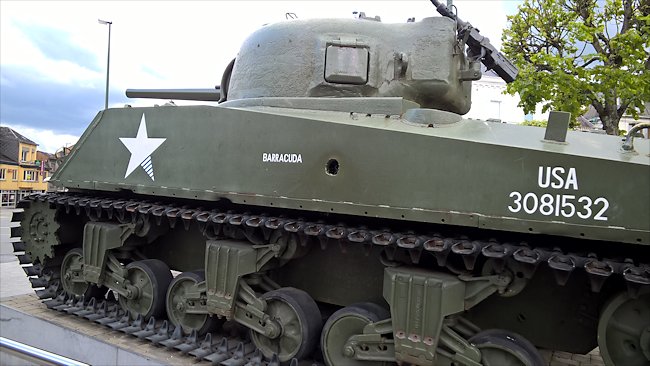
Notice the shell hole in the side of the chassis of the M4A3(75)W Sherman Tank in Bastogne Belgium caused by a German 75mm gun.
Gunner Peterman and Laoder Herbert received medical treatment for their wounds. They survived and were sent to Stalag XIIA near Limburg, Germany as POWs. Driver Urda and Hull Machine Gunner Goldstein were also sent to Stalag XIIA, but they were not given the full rights of a prisoners of war. Goldstein had been identified as a Jew by his dog tags, and a letter in his pocket from his mother, reminding him to observe the Jewish holiday, Hanukkah. Andrew Urda was also identified as a Jew because of his dog tags.
Goldstein and Urda narrowly escaped execution. The were treated as slave laborours, brutally overworked and starved. When they were liberated near the end of the war, the two severely emaciated captives spent many months recovering in US Army Hospitals. Andrew Urda never fully recovered from his mistreatment in captivity. He died in 1979. Ivan Goldstein’s health was eventually restored. He moved to Jerusalem.
Captain Ameno’s tank was also destroyed, killing him and four members of his crew. The fifth crewman was wounded, but died in captivity a short time later. His tank was not saved from the scrap metal merchants blow torch.
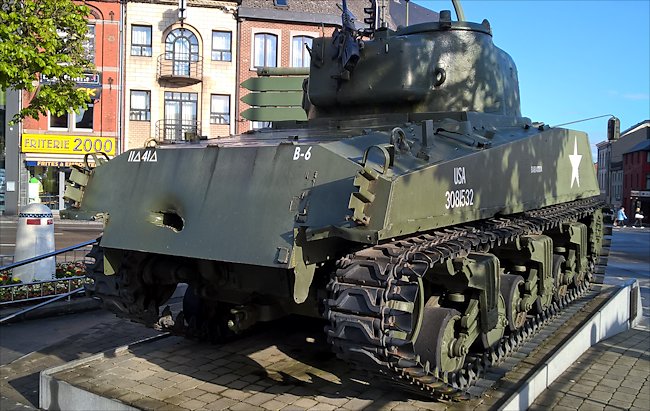
Notice the shell hole in the rear of the Bastogne Sherman caused by a German infantry hand held Panzerfaust anti-tank weapon.
What happened to Baracuda after WW2?
After the war the farmer Mousier Denis refused to allow the tank to be cut up by the scrap metal merchants. He feared that the work would pollute the nearby fresh water spring that he relied upon for his own household water and water for his farm animals and crops. Finally he allowed the Belgium army to tow the tank off his land rather than letting the scrap metal merchants cutting it up in situ as was normal practice. By this time it was one of the few tanks left in tact. The Bastogne Commissioner of Tourism saw its value as a memorial and arranged for its purchase and restoration. It was placed in McAuliffe Square in Bastogne, in 1946 and enshrined in 1948.
This M4A3 Sherman Tank symbolically represents the relief of the besieged city of Bastogne by the US 3rd Army under the command of General Patton in December 1944. The city of Bastogne was encircled by advancing German tanks and troops as they made a mad dash for the port of Antwerp during the winter Ardennes Offensive that was later to be known as the Battle of the Bulge.
This tank has lots of battle scars. On its left side there a hole that was caused by a hit from a German armour piercing 75mm shell. In the rear is another more jagged hole caused by a German infantry hand held Panzerfaust anti-tank weapon that would have destroyed the tank's engine.
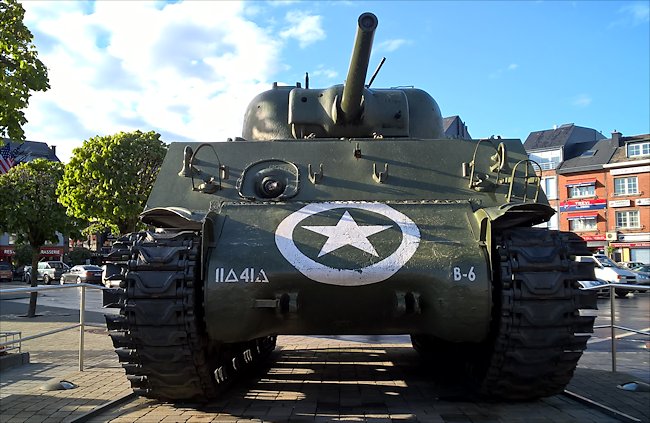
The standard 75mm short barreled gun on this M4A3(75)W Sherman Tank in Bastogne Belgium could not penetrate the frontal armour of a Panther or Tiger Tank.
Sherman Vs Panther
Here is an account of a Sherman tank crew commander from the 712th Tank Battalion as they headed towards Bastogne. 'When it did get light enough to see that the tanks at the bottom of the hill were indeed German Mark V Panthers, I had my gunner lay our gun on the closest German tank. He fired. Our 75 mm Armour piercing AP round bounced off the German tank.'
'My loader reloaded and we fired again with the same result. I believe we fired three or four rounds of armor piercing ammo at this German tank. None of our rounds caused him any damage. In the meantime, the German tank had picked up our position from the muzzle blast of our tank gun. He laid his gun on our tank and began firing. After my tank was hit, it began to burn.'
Ambushed by Panthers
Here is another account from a Sherman tank crew commander from the 712th Tank Battalion. 'We were on the side of a hill and we were putting brush on to camouflage our Sherman tank and I heard Whang! The Sherman just above mine, higher on the hill and sideways had been hit and was starting to burn. I looked out in to the mist and saw a German Panther, maybe 2,000 yards away.
I saw another flash and at the same time I saw Tambar, tank crew from the hit Sherman, go running by and he had blood and stuff all over him. And I said to myself in my subconscious mind, ' 'How the hell is he running with his guts all over him?" But it wasn't his. It was the guy next to him. I said to Babe Harrell our tank driver, 'Never mind this goddamn brush, let's get out of here.' So we pulled out with brush and all.'
Read more in these two tank books

